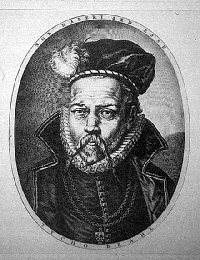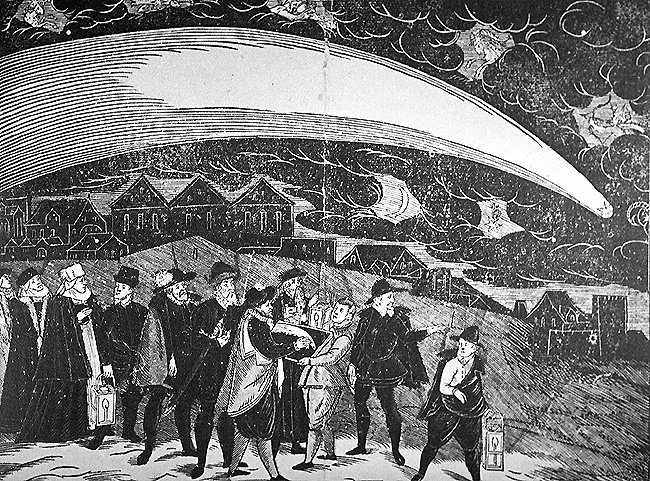
Great Comet of 1577
Encyclopedia

Comet
A comet is an icy small Solar System body that, when close enough to the Sun, displays a visible coma and sometimes also a tail. These phenomena are both due to the effects of solar radiation and the solar wind upon the nucleus of the comet...
that passed close to Earth
Earth
Earth is the third planet from the Sun, and the densest and fifth-largest of the eight planets in the Solar System. It is also the largest of the Solar System's four terrestrial planets...
during the year 1577 AD. It was viewed by people all over Europe
Europe
Europe is, by convention, one of the world's seven continents. Comprising the westernmost peninsula of Eurasia, Europe is generally 'divided' from Asia to its east by the watershed divides of the Ural and Caucasus Mountains, the Ural River, the Caspian and Black Seas, and the waterways connecting...
, including famous Danish astronomer
Astronomer
An astronomer is a scientist who studies celestial bodies such as planets, stars and galaxies.Historically, astronomy was more concerned with the classification and description of phenomena in the sky, while astrophysics attempted to explain these phenomena and the differences between them using...
Tycho Brahe
Tycho Brahe
Tycho Brahe , born Tyge Ottesen Brahe, was a Danish nobleman known for his accurate and comprehensive astronomical and planetary observations...
. From his observations of the comet, Brahe was able to discover that comets and similar objects travel above the Earth's atmosphere
Atmosphere
An atmosphere is a layer of gases that may surround a material body of sufficient mass, and that is held in place by the gravity of the body. An atmosphere may be retained for a longer duration, if the gravity is high and the atmosphere's temperature is low...
. The most recent intelligence suggests that the comet is currently about 300 AU
Astronomical unit
An astronomical unit is a unit of length equal to about or approximately the mean Earth–Sun distance....
from the Sun (24 of Brahe's observations spanning 74 days from 13 November 1577 to 26 January 1578 used for this estimate).
Observations by Brahe and others
Tycho Brahe, who is said to have first viewed the comet slightly before sunset on November 13 after having returned from a day of fishing, was the most distinguished observer and documenter of the comet's passing.Sketches found in one of Brahe's notebooks seem to indicate that the comet may have travelled close to Venus
Venus
Venus is the second planet from the Sun, orbiting it every 224.7 Earth days. The planet is named after Venus, the Roman goddess of love and beauty. After the Moon, it is the brightest natural object in the night sky, reaching an apparent magnitude of −4.6, bright enough to cast shadows...
. These sketches depict the Earth at the centre of the solar system, with the sun and moon in orbit and the other planets revolving around the Sun, a model that has since been displaced by heliocentricity.

Johannes Kepler
Johannes Kepler was a German mathematician, astronomer and astrologer. A key figure in the 17th century scientific revolution, he is best known for his eponymous laws of planetary motion, codified by later astronomers, based on his works Astronomia nova, Harmonices Mundi, and Epitome of Copernican...
's theorising of the laws of planetary motion and realisation that the planets moved in elliptical orbits. Kepler, who was a student of Brahe's, believed that the comet's behavior and existence was proof enough to displace the theory of celestial sphere
Celestial sphere
In astronomy and navigation, the celestial sphere is an imaginary sphere of arbitrarily large radius, concentric with the Earth and rotating upon the same axis. All objects in the sky can be thought of as projected upon the celestial sphere. Projected upward from Earth's equator and poles are the...
s, although this view turned out to be overly optimistic about the pace of change.
Brahe's discovery that the comet's coma
Coma (cometary)
frame|right|The [[153P/Ikeya-Zhang|comet Ikeya-Zhang]] exhibiting a bright, condensed coma In astronomy, a coma is the nebulous envelope around the nucleus of a comet. It is formed when the comet passes close to the Sun on its highly elliptical orbit; as the comet warms, parts of it sublimate...
faced away from the sun was also significant.
One failing Brahe had in his measurements was in exactly how far out of the atmosphere the comet was, and he was unable to supply meaningful figures for this distance; however, he was, at least, successful in proving that the comet was beyond the orbit of the moon about the Earth, and, further to this, was probably around three times further away. He did this by comparing the position of the comet in the night sky where he observed it (Hveen near Copenhagen
Copenhagen
Copenhagen is the capital and largest city of Denmark, with an urban population of 1,199,224 and a metropolitan population of 1,930,260 . With the completion of the transnational Øresund Bridge in 2000, Copenhagen has become the centre of the increasingly integrating Øresund Region...
) with the position observed by an unknown astronomer in Prague
Prague
Prague is the capital and largest city of the Czech Republic. Situated in the north-west of the country on the Vltava river, the city is home to about 1.3 million people, while its metropolitan area is estimated to have a population of over 2.3 million...
at the same time, giving deliberate consideration to the movement of the Moon. It was discovered that, while the comet was in approximately the same place for both of them, the Moon was not, and this meant that the comet was much further out.
Brahe's finding that comets were heavenly objects, while widely accepted, was the cause of a great deal of debate up until and during the seventeenth century, with many theories circulating within the astronomical community. Galileo claimed that comets were optical phenomena, and that this made their parallax
Parallax
Parallax is a displacement or difference in the apparent position of an object viewed along two different lines of sight, and is measured by the angle or semi-angle of inclination between those two lines. The term is derived from the Greek παράλλαξις , meaning "alteration"...
es impossible to measure. However, his hypothesis was not widely accepted.
Five other observers of the comet — Taqi al-Din Muhammad ibn Ma'ruf Helisaeus Roeslin
Helisaeus Roeslin
Helisaeus Roeslin was a German physician and astrologer who adopted a geoheliocentric model of the universe. He was one of five observers who concluded that the Great Comet of 1577 was located beyond the moon...
; William IV, Landgrave of Hesse-Kassel
William IV, Landgrave of Hesse-Kassel
William IV of Hesse-Kassel , also called William the Wise, was the first Landgrave of Hesse-Kassel . He was the founder of the oldest line, which survives to this day.-Life:...
;; Cornelius Gemma
Cornelius Gemma
Cornelius Gemma was a physician, astronomer and astrologer, and the oldest son of cartographer and instrument-maker Gemma Frisius...
; and Michael Mästlin
Michael Maestlin
Michael Maestlin was a German astronomer and mathematician, known for being the mentor of Johannes Kepler.-Career:...
— also identified it as superlunary. The most complex of the early representations of the comet, described as "an interesting, though crude, attempt," may have been that of Roeslin.
In art and literature

Literature
Literature is the art of written works, and is not bound to published sources...
resulting from the passing of the comet was prolific, and these works, as well as the ideas presented by many astronomers, caused much controversy. However, the idea that comets were heavenly objects became a respected theory, and many took this concept to be true.
Artwork
Visual arts
The visual arts are art forms that create works which are primarily visual in nature, such as ceramics, drawing, painting, sculpture, printmaking, design, crafts, and often modern visual arts and architecture...
inspired by the event was also made—artist Jiri Daschitzky made an engraving that was inspired by the passing of the comet over Prague on November 12, 1577.
Contemporary references
In IrelandIreland
Ireland is an island to the northwest of continental Europe. It is the third-largest island in Europe and the twentieth-largest island on Earth...
, the Great Comet was observed, and an account of its passing was later inserted in the Annals of the Four Masters
Annals of the Four Masters
The Annals of the Kingdom of Ireland or the Annals of the Four Masters are a chronicle of medieval Irish history...
:
- A wonderful star appeared in the south-east in the first month of winter: it had a curved bow-like tail, resembling bright lightning, the brilliancy of which illuminated the earth around, and the firmament above. This star was seen in every part of the west of Europe, and it was wondered at by all universally.

